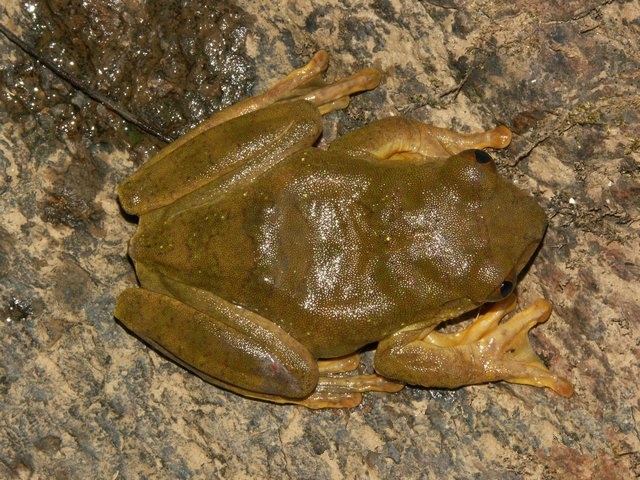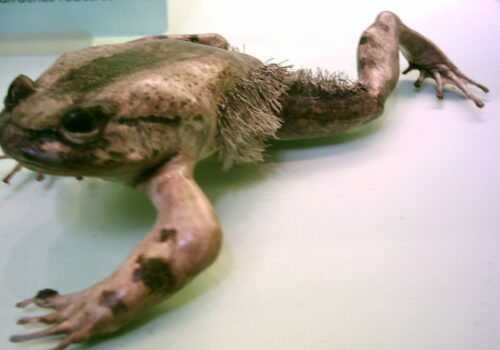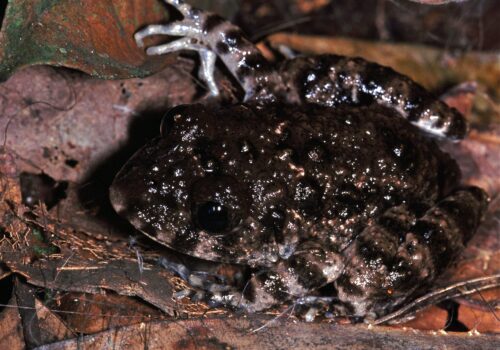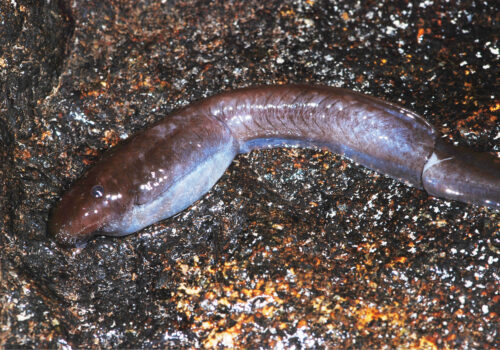- Exploring the Enigmatic Red Tree Frog: A Comprehensive Look at <em>Leptopelis rufus</em>
- Taxonomy and Classification: Understanding <em>Leptopelis rufus</em>
- The Natural Habitat: Where the Red Tree Frog Thrives
- Physical Characteristics: The Splendid Appearance of Red Tree Frogs
- Behavior and Life Cycle: Insights into Their Secretive Lives
- Ecological Role: An Indispensable Amphibian
- Threats and Conservation Status: Protecting a Forest Jewel
- Cultural and Scientific Significance: A Frog of Fascination
- Conclusion: Championing the Red Jewel of the Rainforest
Exploring the Enigmatic Red Tree Frog: A Comprehensive Look at Leptopelis rufus#
Tucked away in the vibrant greenery, humid air, and enchanting twilight songs of Africa’s tropical rainforests, lives a captivating creature—Leptopelis rufus, commonly known as the Red Tree Frog. Cloaked brightly in stunning hues, these frogs quietly claim their right as jewels of their ecosystem. From their elusive habits in dense canopies to their fascinating reproductive rituals, much about the Red Tree Frog remains beguilingly mysterious.
Leptopelis rufus belongs to the diverse and ecologically essential frog genus Leptopelis, representing some of the continent’s most vibrant tree frogs. Despite their radiant presence, these creatures often go unnoticed, their melodic calls faint whispers amongst nature’s symphony. In this article, we’ll journey deep into their hidden world, exploring the lives, roles, and conservation landscapes surrounding this unique amphibian.
Taxonomy and Classification: Understanding Leptopelis rufus#
To appreciate the beauty and ecological significance of the Red Tree Frog, it’s essential to first grasp its place within the vibrant spectrums of taxonomy. Leptopelis rufus resides firmly within the family Arthroleptidae, characterized by a diverse group of amphibians affectionately known as squeakers or tree frogs and representing a vast and adaptive branch of African biodiversity.
The genus Leptopelis, with over 50 species scattered across sub-Saharan Africa, paints an evolutionary tapestry of adaptability. Species within this genus vary immensely in coloration, vocalization, and ecology, yet they share structural similarities and reproductive behaviors. Closely related species, such as Leptopelis flavomaculatus or Leptopelis argenteus, mirror closely the niche, structure, and habits of Leptopelis rufus, though each exhibits distinct and fascinating adaptations.
The Natural Habitat: Where the Red Tree Frog Thrives#
Finding the Red Tree Frog in its natural setting is always a thrilling moment. Primarily distributed across the lush equatorial forests stretching from eastern Cameroon down through Gabon and into the heartlands of Congo, Leptopelis rufus is a true creature of Africa’s richly wooded terrain.
Lush Realms of the Tropical Rainforest#
Unlike ground-dwelling frogs, the Red Tree Frog feels most at home among the leafy arboreal heights. Within this three-dimensional jungle mosaic, they inhabit zones ranging from dense understory layers up into mid-level canopies. These amphibians meticulously choose habitats characterized by abundant moisture, shaded from harsh sunlight, scientific testament to their sensitivity to water loss through evaporation.
Specifically, areas featuring ample standing water, such as seasonal ponds and marshy depressions, are deemed essential for their breeding cycles. Mature trees, dense shrubbery, and thick, leafy vines collectively form a spatial haven, facilitating both camouflage and the frog’s delicate balancing dance between predator avoidance and effective prey capture.
Physical Characteristics: The Splendid Appearance of Red Tree Frogs#
At first glance, Leptopelis rufus draws immediate attention. Measuring roughly 4 to 6 centimeters in length, this mid-sized tree frog boasts a vivid color palette that ranges from deep maroon or rich russet tones to vibrant orange-reds. This striking coloration lends the species its common moniker and increases its allure to wildlife enthusiasts and biologists alike.
A Masterpiece of Adaptation and Camouflage#
The species’ large, expressive eyes possess vertically elliptical pupils, enabling superb nocturnal vision. Their nimble bodies are made agile and capable of swift leaps by numerous adaptations, including muscular hind legs and cushion-like toe pads that confer perfect adherence to slippery leaves and twigs. Skin texture varies subtly—often smooth to finely granular—helping them blend effortlessly within their verdant surroundings.
One fascinating adaptation resides within their dermis. Subtle changes in brightness and shading help provide effective camouflage, crucial in escaping attention of predatory snakes, birds, and mammals prowling the foliage. Indeed, coloration and pattern not only catch the observer’s eye but also signify intricate ecological and evolutionary strategies within the species’ survival arsenal.
Behavior and Life Cycle: Insights into Their Secretive Lives#
The lives of Red Tree Frogs unfold quietly but dramatically amid rainforest shadows. These frogs spend daylight hours in restful solitude, cleverly concealed under the shade or nestled against moist vegetation. With the dimming twilight, their nocturnal instincts awaken, triggering a suite of behaviors intricately linked to survival and reproduction.
A Melodious Serenade: Courtship Calls and Mating Rituals#
Male frogs exhibit a unique vocal prowess, broadcasting distinctive trills, whistles, and croaks from carefully chosen perches at dusk. These melodious serenades, amplified by forest acoustics, echo through the understory, attracting female frogs who seek mating partners using auditory cues. Females carefully assess calls—pitch and frequency serve as indicators of male health and fitness.
Upon pairing, female frogs deposit masses of gelatinous eggs along aquatic vegetation or surface waters in shallow pools. Notably, parental investment is minimal—these eggs left unguarded—and they develop rapidly, hatching into lively, aquatic larvae, known as tadpoles.
Development and Survival: From Tadpole to Tree Dweller#
The ensuing weeks of tadpole life are critical. Tadpoles graze upon algae, microorganisms, and detritus, steadily growing until limbs gradually emerge and metamorphosis commences. Upon transitioning to fully terrestrial juveniles, they quickly adopt arboreal lifestyles, where physical and behavioral adaptations immediately come into action—enhancing survival rates despite predation pressures.
Ecological Role: An Indispensable Amphibian#
In the complex web of life inhabiting rainforest ecosystems, the Red Tree Frog occupies a vital ecological niche. As both predator and prey, Leptopelis rufus helps balance ecosystem dynamics.
Connections within the Food Web#
Adult frogs enthusiastically consume insects, spiders, and other small invertebrates, ensuring balanced populations and reduced pest pressures. Simultaneously, frog larvae (tadpoles) diligently graze on algae, keeping water bodies healthy and clear. Conversely, frogs and tadpoles themselves are critical food resources for predatory insects, birds, reptiles, and mammals, ensuring energy and nutrient cycling within their habitats.
Moreover, frogs’ sensitivity to environmental changes positions them as reliable indicator species—signaling shifts within forest ecosystems due to pollution, temperature fluctuations, or habitat degradation long before other organisms reflect similar stresses.
Threats and Conservation Status: Protecting a Forest Jewel#
Although currently categorized as a species of “Least Concern” by the International Union for Conservation of Nature (IUCN), the habitat of Leptopelis rufus faces mounting pressures. Habitat destruction through logging, agriculture, and urban encroachment threatens their long-term survival. Additional environmental concerns—climate change, disease prevalence (specifically chytridiomycosis), and pollution—pose amplified combined threats, heightening urgency for proactive conservation measures.
Current Conservation Efforts#
Fortunately, increased conservation awareness and expanded protected areas within African rainforests bode well for their future. Researchers and local conservation organizations are collaborating to monitor populations, protect breeding habitats, and educate communities about the importance of preserving both the species and the healthy ecosystems that sustain them.
Cultural and Scientific Significance: A Frog of Fascination#
Beyond their ecological importance, Red Tree Frogs hold a unique scientific intrigue. Studies into their vocalization, behavior, and physiology contribute valuable insights into amphibian biology and conservation methodologies. For centuries, indigenous communities have respected these vibrant creatures—weaving myths, legends, and symbols combining admiration, mystery, and reverence for their conspicuous colors, remarkable songs, and elusive lives.
Conclusion: Championing the Red Jewel of the Rainforest#
Leptopelis rufus beautifully exemplifies the resilience, importance, and delicate balance of wildlife in Africa’s equatorial ecosystems. Yet, their story remains incomplete without our conscious acknowledgment and dedicated support. As advocates, students, or nature enthusiasts, we carry the responsibility not just to marvel at their charm but to champion their continued existence.
Preserving rainforests, respecting biodiversity, and promoting awareness helps safeguard these captivating frogs and countless other species. Let the enigmatic Red Tree Frog inspire us to protect and cherish the natural grandeur that surrounds us—improving our world one frog at a time.


















